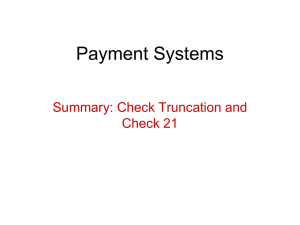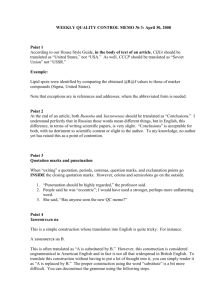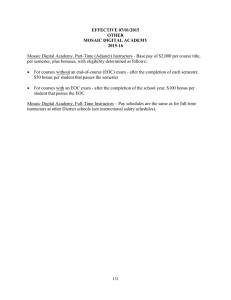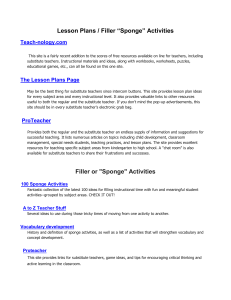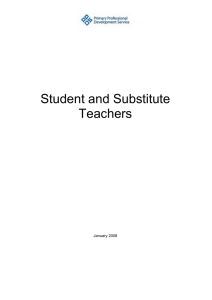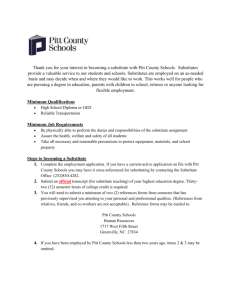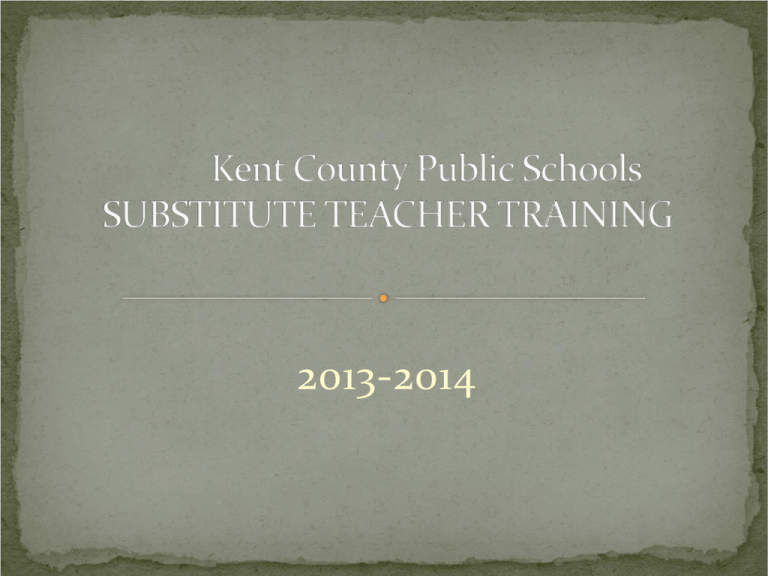
2013-2014
• Equal employment opportunity
• Substitutes are important
• Roles and responsibilities of the substitute teacher
• Classroom management and discipline
• Need assistance, who do you ask?
• The daily routine
• Substitute teacher notification procedure-AESOP
• Resources
• Kent County Public Schools does not discriminate
against any employee or applicant for employment
because of race, color, religion, sex, national origin,
age, disability, military status, genetic information, or
on any other basis prohibited by law. Employment
decisions will be made on the basis of each applicant’s
job qualifications, experience, and abilities.
•
We value and appreciate you- our substitutes.
• Students and our schools benefit when substitutes
are well trained when they enter the classroom and
actively instruct.
• Substitute teaching, just as full-time teaching,
comes with many responsibilities.
•
SCHOOL SAFETY- First and foremost- You assist
the district in keeping all students safe.
Remain attentive and focused on your
students at all times. Awareness of what
is transpiring in your classroom is crucial.
1.
•
•
•
Reading newspapers, working on the computer,
reading books is not allowed during class time.
Personal calls on cell phones are to be made at
lunch and during planning periods.
Never leave a class unsupervised.
2.
3.
Confidentiality—Confidential student information
is protected by state law. As a substitute teacher, you
will come into contact with knowledge of grades,
behavior, and socio-economic conditions. **There is
NEVER a reason to take this information from school
and discuss it with others.
Internet- The district has a protective filter. Attempts
to view inappropriate websites is unacceptable,
traceable, and can be against the law.
4.
•
•
Sharing political, religious, and/or social
beliefs.
Your ideas, opinions, and beliefs are a part of who
you are as an individual.
However, it is required that you adhere to the
teachers’ lesson plans and follow his or her
instructions as closely as possible.
5.
Desired professional demeanor- Enthusiastic,
compassionate, and positive attitude.
You are responsible for a climate of mutual respect which can
be established with genuine concern for the students.
Keep the classroom door open when talking with
students.
Avoid any behavior that could be misinterpreted when
interacting with students.
• Use verbal praise and reinforcement.
• Candy may not be used as an incentive.
• Avoid losing your temper.
• Do Not take children home with you and never transport
them in your car.
•
Do Not make telephone calls, text message, use Facebook
or write notes of a personal nature to students.
• Respect students and their cultural/diverse
backgrounds.
• Use only proper humor (avoid sexual and racial
jokes or humor).
• The information you may hear from students is
confidential.
• Avoid criticizing others.
6.
Legal Aspects
Supervision of Students
A teacher (or substitute) is required to exercise
care and caution for the safety of the students in
his/her charge. This means act reasonably and with
safety in mind, being able to explain circumstances
and your actions, as well as following school safety
policies and procedures.
Release of Students
Due to possible restraints on who may have custody of
a child, children should not be allowed to leave the
building during a school day without consent from the
office.
Administering Medicine
Medication should only be administered by school
nurse or other appropriate personnel, not the classroom or
substitute teacher.
Advice from School Nurses:
•Refer all students with injuries (even minor) to the school
nurse or the office.
•Wear protective gear with any bodily fluids.
•Any child that is bleeding, provide a bandage or send to the
school nurse.
•Prevention is the best antidote for emergencies. Always stay
with students and never leave students unattended.
7. Records/Notes on Incidents
Maintaining notes on particular incidents in the
classroom can protect you in problematic situations. If
you feel that your actions might be questioned, note
the date and time, the individuals involved, the choices
for action considered, and the actions taken. (Notes to
Teacher – Brief description of the day)
8. Discipline Procedures
• When sending a student to the principal for discipline
issues, the substitute teacher maintains the duties of
supervision and care for both the individual child and the
remainder of the class.
• Actions to consider include:
utilize the intercom to call the office
have another student accompany the student
send a student to bring someone from the office
or, have another teacher watch your class while you take
the child to the office.
9. Safety and Crises Drills
•
•
•
All visitors in KCPS buildings must wear a badge that
indicates they signed in at the front office.
Review the Crises Procedures when you come to a new
classroom – exit route, location of the “go bucket”,
attendance clipboard and sign out sheets.
When the fire drill bell sounds, take the “go bucket”
and clipboard, line up the students in an orderly
fashion, and follow the evacuation route.
1.
2.
3.
Engaging Students—be sure you have the attention of
everyone in your classroom before you start your
lesson. Do not attempt to teach over the chatter of
students not paying attention.
Direct Instruction—begin each class by telling the
students exactly what will be happening. The teacher
outlines what he/she and the students will be doing
this period. Time limits may be set for some tasks.
State expectations for behavior prior to the activity or
lesson.
4.
5.
Monitoring—Actively move around room. Check on
progress and provide individualized instruction as
needed.
Modeling—Teachers who are courteous, prompt,
enthusiastic, in control, patient and organized provide
examples for students through their behavior. If you
want students to use quiet voices in the classroom
while they work, you too will use a quiet, but assertive
voice as you move through the room helping students.
6.
7.
Non-Verbal Cues—Non-verbal cues can be facial
expressions, body posture, hand signals, or proximity to
a student. Care should be given in choosing the types of
cues you use in your classroom. Take time to explain
what you want the students to do when you use your
cues.
Low-Profile Intervention—Intervention should be quiet
and calm between teacher and student. De-escalation
techniques should be used if a student becomes upset.
Proactive measures will decrease the chance of a student
misbehaving.
8.
9.
Positive Discipline—use classroom rules that describe
the behaviors you want instead of listing things the
students cannot do. Instead of “no running in the
room,” use “walk from one station to another.” Refer to
the rules as expectations. Let your students know this is
how you expect them to behave in class.
Redirecting Behavior—Describe the problem, describe
the desired behavior, check for understanding, and
provide positive feedback.
•
If possible, talk privately with students who need
redirection.
•
Watch attention spans—it is important to pace a
lesson and recognize when to change activities,
speed up, or slow down.
•
•
•
•
Treat all pupils with fairness and impartiality
Be alert—spot potential behavior problems in the early
stages and take action before the situation escalates
Remember that some students will test a substitute
teacher to determine his or her behavior limits.
Stress to students that they must assume some
responsibility for their own actions.
Students will sometimes suggest certain activities or
procedures which vary from the regular teacher’s
routine. If such a situation arises, be pleasant but
firm as to how things are going to be done that day.
Try to adhere as closely as possible to the regular
teacher’s schedule.
Special Needs
• If a student does not comply, consider what might be
the problem
• Use visual cues to support appropriate behavior for all
students
• Do not allow students to move their seats, etc.
• When most students have completed an activity, move
on
• Talk with grade level or content area
teachers
• Secretaries are great resources
• Principals are here to help
• Arrive on time• Dress professionally—appearance makes a
difference
• Substitutes are not allowed to bring their
personal children to the assigned classroom.
• Follow the teacher’s lesson plan and
schedule as given to you.
Prior to Entering the Classroom
• Check-in at the campus office
• Obtain any keys that might be necessary
• Ask about special procedures and schedules
• Extra duties associated with the assignment – lunch,
after school, etc.
• School-wide events planned for the day- assemblies,
field trips, etc.
• Attendance procedures
• Student medical concerns
In the Classroom Prior to Students Arrival
•
•
•
•
•
Write your name on the board (Mr. Smith)
Review any posted expectations and rules
Review evacuation maps and any emergency data
Read through the lesson plans
Locate books and materials which will be needed
throughout the day.
• Study the seating charts
• Greet students with confidence as they enter the
classroom
Throughout the Day
• Carry out the lesson plans and assigned duties to
the best of your ability.
• Be positive and respectful in your interactions with
students and school personnel.
At the end of each class period or day
• Account for all classroom materials
• Have students straighten and clean the area around their
•
•
•
•
•
•
desk.
Remind students of homework
Write a brief report of your day and leave it for the
classroom teacher
Neatly organize the papers turned in by the students.
Close windows and turn off lights and equipment.
Make sure the room is in good order before you lock the
door.
Turn in keys and any money collected to the office
• Talk with grade level or content area
teachers
• Secretaries are great resources
• Principals are here to help
• You can email Krystal Proctor,
kproctor@kent.k12.md.us or call her at her
desk 410-778-7140.
You arrive at the school 15 minutes early and the lesson
plan that were left make no sense at all. You look for
the materials and they are not there. What should you
do?
You accept a third-grade position at one of the
elementary schools, and when you arrive you are
moved to an assistant position with a special needs
child. There are no plans, and you are told that you
need to stay with the child for the whole day. You have
never worked with a student like this and you feel very
uncomfortable. What do you do?
You are placed in a classroom for the day. The lesson
plan seems complicated and when you try to teach the
lesson, the students complain that the work is too
hard. The students become very chatty, and when you
try to bring them back on task, they moan that they
can’t do the work. What do you do?
Thank-you for your
attendance.

